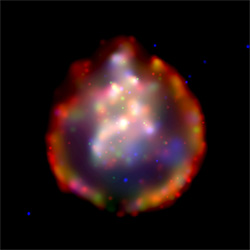May 26, 2003
CXC Press Release: 03-03
Scientists using NASA's Chandra X-ray Observatory have detected large amounts of oxygen and other elements in the remnant of a star that exploded in a nearby galaxy. For years scientists have known that the elements necessary for life are created in massive stars and dispersed in supernova explosions, but the process has rarely been caught "on camera."
The Chandra image of supernova remnant, SNR 0103-72.6, shows a striking, nearly perfect ring about 150 light years in diameter surrounding a cloud of gas enriched in heavy elements and shock heated to millions of degrees Celsius. The ring marks the outer limits of a shock wave produced as material ejected in the supernova explosion plows into the interstellar gas. The size of the ring indicates that we see the supernova remnant as it was about 10,000 years after its progenitor star exploded.
According to Dr. Sangwook Park of Penn State University in University Park, lead author of a presentation today at the meeting of the American Astronomical Society in Nashville, Tenn., "Hundreds of supernova remnants are scattered throughout our galactic neighborhood, but we detect only a handful rich in oxygen. This Chandra image is a rare treat."
Oxygen is synthesized by nuclear reactions in the interiors of stars at least ten times as massive as the Sun. When such a star explodes, its core collapses to form either a neutron star, or if massive enough, a black hole, and the material surrounding the core is propelled into interstellar space.
"The most abundant elements in this remnant are oxygen and neon," Park said. "Their location near the center of the remnant is evidence that the progenitor star was at least ten times as massive as the Sun."
SNR 0103-72.6 is located in the Small Magellanic Cloud (SMC) about 190,000 light years from Earth. The X-rays take about 190,000 years to reach us from the SMC, so the supernova explosion occurred about 200,000 years ago, as measured on Earth. One of the closest galaxies to the Milky Way galaxy, the SMC is visible to the naked eye from the Southern Hemisphere
"This supernova remnant will become a laboratory for studying how stars forge the elements necessary for life," said Park. Although SNR 0103-72.6 is more distant than supernova remnants in our Galaxy, scientists have a clear view of it because its light is not blocked by the dusty spiral arms of the Milky Way.
Other members of the team involved in this observation are David Burrrows, John Nousek and Gordon Garmire of Penn State; John Hughes of Rutgers University in Piscataway, N.J., and Patrick Slane of the Harvard-Smithsonian Center for Astrophysics in Cambridge, Mass. Garmire is the principal investigator on this observation.
The ACIS instrument was built for NASA by Penn State and the Massachusetts Institute of Technology under the leadership of Garmire. NASA's Marshall Space Flight Center manages the Chandra program, and TRW, Inc., Redondo Beach, Calif., is the prime contractor for the spacecraft. The Smithsonian's Chandra X-ray Center controls science and flight operations from Cambridge, Mass., for the Office of Space Science at NASA Headquarters, Washington.
The image and additional information are available at:
MEDIA CONTACTS
Steve Roy
Marshall Space Flight Center, Huntsville, AL
Phone: 256-544-6535
Megan Watzke
Chandra X-ray Observatory Center, CfA, Cambridge, MA
Phone: 617-496-7998



